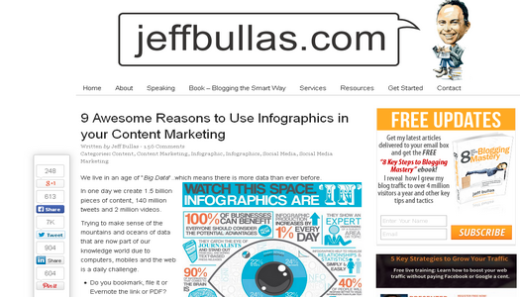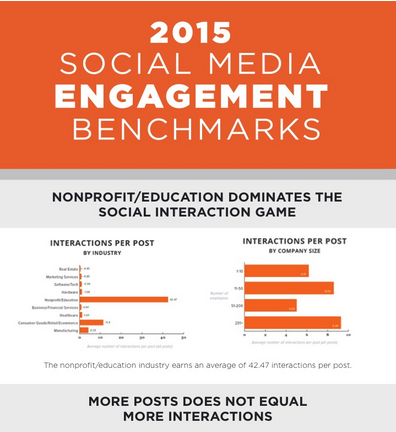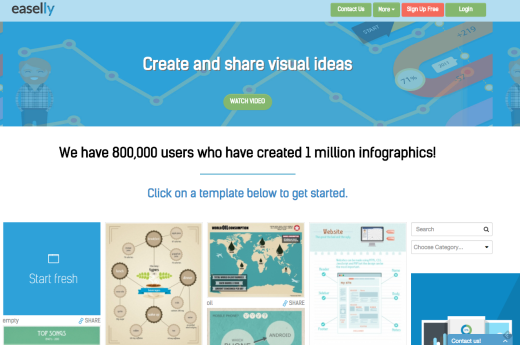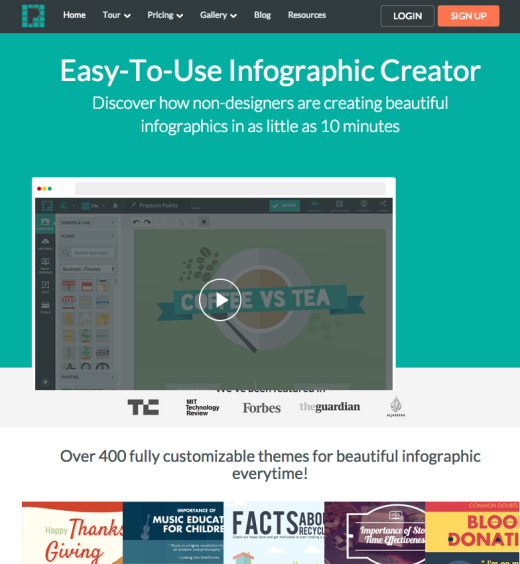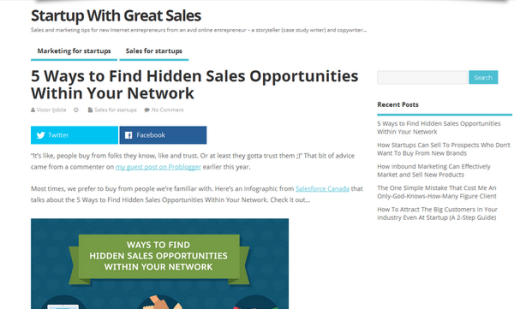
As founders, we are conceptualizers, thinkers, leaders, developers and most of all, we are change agents.
We obviously oversee the most serious issues in business; do we really have to get worked up with all those SEO tips and tweaks we hear all the time? Definitely not. Our SEO guy should take care of those.
But if anything, startup founders need to pay attention to one piece of jargon in SEO: inbound links.
“…if you do enough excellent, interesting, useful, funny, compelling stuff, usually your reputation, or your links, however you want to think of it, takes care of itself.” says Matt Cutts.
He literally referred to your links as “your reputation”. In other words, they are that important. And that’s why founders need garner as many as they can.
But then, this begs the question: if Matt and Google have stuck a fork in one of the most used and effective method of link building — guest blogging, what other link building tactic could replace it? Infographics.
Heck, they even generate more backlinks than most other link building tactics on the Web.
“…these visual content pieces are generating more backlinks than any other form of content I publish, which—in the long run—helps increase my search engine rankings and overall readership numbers.” says Neil Patel — Renowned Internet marketer.
Top content marketing influencer, Jeff Bullas, also mirrors Neil’s idea in his post on 9 awesome reasons to use infographics in content marketing:
“I noticed the power of Infographics about six months ago when I included it in a blog article and was surprised by the traffic response. On taking a closer look at its popularity, I decided to use Google “Insights for Search” analytics to determine the increase in the interest in the keyword “Infographics” as reflected in search volume increases since 2004.
“I discovered (as shown above) that just prior to the start of 2010 to the beginning of 2012, infographic search volumes have increased by over 800 percent in just over two years.” says Jeff.
So that’s pretty much how powerful infographics can influence your rankings — if done rightly.
However, before we go into how infographics can help garner links, let’s take a look at how we can actually create them.
Creating quality infographics
Infographics are truly awesome. However, if creating them were as easy as writing blog posts, I’d be posting them every single day. But really, they involve a lot more time, energy, effort and (sometimes) skills than text-based posts.
There are obviously two basic ways by which you can go about creating infographics: create them via your in-house team or hire a professional.
However, since you’ll find lots of “infographic design agencies” via a simple Google search, I’ll be sharing how you can create quality infographics without having all the skills that professionals possess:
-
Organize a full team brainstorm for fresh and useful content ideas
Instead of leaving the job of generating ideas to just one person, your whole team should get involved. Two heads, they say, are better than one. And after all, content is king, so it’s worth the effort.
At this stage, you’re looking for fresh and useful ideas that your target audience would find useful and interesting.
Justin Briggs, contributor at Moz, mirrors the “Full Team Brainstorm” concept this way:
“At this stage, I’ll pull the whole project team together for a brainstorm. I may start with a seed set of ideas, but this is a wide open brainstorm, anything goes. We’re looking for ideas that are: interesting, appeals to the linkerati / socialrati, has real data, and some type of unique hook.”
However, the need for fresh content can not be over emphasized. You know how much we (humans) crave fresh stuff, right? So here are a few resources you can go to fetch fresh data: FedStats, CIA World Factbook, SocialMention, Google Trends and many more.
-
Create a great design
No matter how fresh and useful your content is, readers would mostly lose their interest if your design is awful. Here are a few tools to help you design an attractive infographic:
HubSpot infographic templates
HubSpot has put together a free resource of which you can draw inspiration from to create your own well-designed infographics right in PowerPoint. All you need to provide is the content to use inside your desired templates.
Here’s a sample of an infographic created using one of HubSpot’s 10 templates:
However, “The important thing is to choose a template that specifically works for the type of data set/content you want to present” says Pamela Vaughan of HubSpot.
Other tools for creating infographics include:
Easel.ly gives you access to free templates to get you started, which are easily customisable using objects like arrows, etc. You can also customize your text with various fonts, colours, text styles and sizes.
Piktochart allows you to create infographics using a combination of different types of visualizations: themes, icons, vectors, images and chart exporter with easy drag and drop features.
Checkout a few other tools here.
Now that you know how to create your own infographic, let’s dive straight into…
Using infographics to earn links
Even if you’re a founder who doesn’t actively oversee your site’s marketing/SEO process, here’s a simple formula you could just whisper to your marketing expert:
Tell stories with infographics + email campaign + added value = inbound links
Let’s take a look at how this formula actually morphs into links…
Telling stories with infographics
“Expressing internal emotions is sometimes difficult in text, but is child’s play in pictures or other visuals” says Neil Patel — Renowned Internet marketer.
In other words, infographics tell stories even better than text-based content. So this begs the question: if stories do so much good to text-based content (I mean, we see case studies generate lots of engagements all the time on Groove Hq’s blog), how much more could infographics generate?
“I personally love when a company sells me a story vs hard facts”
“I totally agree, people can bond lot easier and faster over a great story. I am all for it…”
Those statements came from two commenters on my guest post on Inbound.org a few days ago, in which I break down how stories can be used to suck people into our own world.
“When Buffer co-founder Leo Widrich started to market his product through stories instead of benefits and bullet points, sign-ups went through the roof.” says Lifehacker.
In a nutshell, whenever narratives are involved, we (humans) tend to be more attentive. And so, while you’re going to be using data and hard facts, let your infographics be themed around stories.
Email campaign + added value
If you’re a startup, you know you haven’t been around for so long that folks will be posting your infographics on their blogs voluntarily. So you need to manually reach out to them.
And when you do, you definitely don’t want to end up getting ignored or turned down.
A real-life example: Few days ago I got an email from one marketing agency. They recently released an infographic via Salesforce Canada and wanted me to post it on my blog.
All they did was put an embed code beneath the original article on Salesforce so people can just copy it, paste on their blogs and link back to Salesforce. And that’s it. The more people post the infographic on their blogs, the more backlinks Salesforce earn. That obviously is such a great way to build links, right?
But really, how do you ask for this huge favour without turning people off? Take a look at the email I received from the design agency:
Hello –
Just read your post, “How Inbound Marketing Can Effectively Market and Sell New Products,” and I thought your post had some fantastic info on how critical inbound marketing is.
Exploration of sales opportunities can sometimes require us to mine our existing contacts. Selling to those within your network does not have to be an uncomfortable process though.
Our design agency recently released an article, featuring custom graphics, with Salesforce Canada that speaks about the 5 Ways to Find Hidden Sales Opportunities Within Your Network: https://www.salesforce.com/ca/blog/2015/05/hidden-sales-opportunities.html
Would you be interested in posting the mini-infographic (located at the bottom of the article) on your site? There is an embed code at the bottom of the article for easy sharing.
As a thank you for posting, we can include your site in our social promotion for this article. Just let me know when your post is live and I can set it up.
Thanks!
Megan.
So through this email, I came up with the following five-paragraph guide for doing email campaign:
- Commend your targets’ recent post right in the first paragraph of your email. It puts them in the right frame of mind to consider your pitch.
- Make sure your infographic’s topic is related and responds to the post you commended in paragraph one. It further convinces them to consider your request.
- Introduce your infographic’s topic.
- Make your request: “Would you be interested in posting the mini-infographic (located at the bottom of the article) on your site?
- So here’s where the added value comes in: they should at least get something in return, so offer them a value. In my case, the design agency offered to promote my site for the infographic on their social channel.
But then, what’s Google’s take on link building via infographics?
Back in 2012, Matt mentioned in an interview that Google may have to devalue links from infographics. But really, you’d notice from that interview that he was only referring to links that automatically show up when folks post an infographic on their site via embed codes. Google may see that as a spammy tactic.
But here’s a better way: if you take a look at how I posted the infographic (below), you’ll see how I opened the post with a few words of introduction, including a link to Salesforce Canada.
“It’s like, people buy from folks they know, like and trust. Or at least they gotta trust them ;)” That bit of advice came from a commenter on my guest post on Problogger earlier this year. Most times, we prefer to buy from people we’re familiar with. Here’s an infographic from Salesforce Canada that talks about the five Ways to Find Hidden Sales Opportunities Within Your Network. Check it out…”
See how I linked to Salesforce Canada? That kind of link carries value. It didn’t automatically show up on the infographic, I endorsed it myself.
So here’s what you should do: instead of merely doing an email campaign, you should send a short introduction of your infographic (attached in a .doc file) alongside your email, and notify them in the body of the email that they don’t have to worry about writing an introduction for the infographic as you have it attached in the email.
So here’s my two cents to startup founders: you really don’t need to know everything about SEO, unless you’re a SEO yourself. Instead, you can narrow your attention down to your inbound links. They are as important as your reputation.
As I’ve explained above, infographics are just pretty much a great way to go about this.
Read Next: 9 qualities of world class growth hacking teams
Image credit: Shutterstock
Get the TNW newsletter
Get the most important tech news in your inbox each week.
